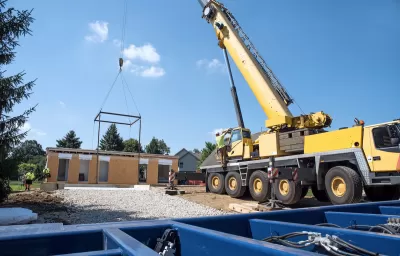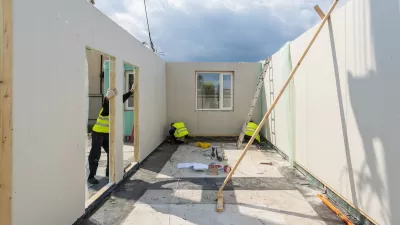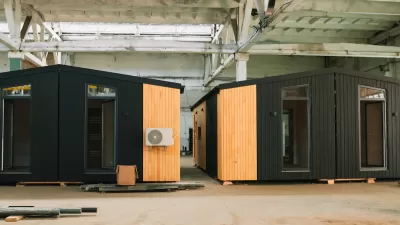Modular housing can be built faster and at lower cost than traditional homes, but the industry is stymied by regulatory and other barriers.

A report published by the Center for American Progress outlines the benefits of modular home construction and how, with some support, the industry could help bring more housing to market in the United States. “Modular homes are constructed off-site, but in contrast to manufactured housing, they are assembled on-site and attached to a permanent foundation,” the report explains.
“Modular construction has many potential benefits, including cost savings, shorter development timelines, and an overall safer and more efficient development process.” However, modular construction is growing slowly in the United States due to barriers that include “financing and payment schedules; scarcity of manufacturers; lack of consistency in local jurisdictions’ building codes, zoning regulations, and state transportation requirements; and labor shortage.”
The report makes several suggestions for boosting modular building. These include:
- Expand financial resources for the modular construction of affordable housing
- Standardize building codes and land use to facilitate production and project approvals
- Support a more diverse workforce and higher wages in modular construction jobs
- Expand the capacity of modular building
The report concludes that “Modular building, if brought to scale, has the potential to reduce construction costs and make it more affordable to build new homes, especially in areas experiencing severe affordable housing shortages.”
FULL STORY: Increasing Affordable Housing Stock Through Modular Building

Planetizen Federal Action Tracker
A weekly monitor of how Trump’s orders and actions are impacting planners and planning in America.

Maui's Vacation Rental Debate Turns Ugly
Verbal attacks, misinformation campaigns and fistfights plague a high-stakes debate to convert thousands of vacation rentals into long-term housing.

San Francisco Suspends Traffic Calming Amidst Record Deaths
Citing “a challenging fiscal landscape,” the city will cease the program on the heels of 42 traffic deaths, including 24 pedestrians.

Amtrak Rolls Out New Orleans to Alabama “Mardi Gras” Train
The new service will operate morning and evening departures between Mobile and New Orleans.

The Subversive Car-Free Guide to Trump's Great American Road Trip
Car-free ways to access Chicagoland’s best tourist attractions.

San Antonio and Austin are Fusing Into one Massive Megaregion
The region spanning the two central Texas cities is growing fast, posing challenges for local infrastructure and water supplies.
Urban Design for Planners 1: Software Tools
This six-course series explores essential urban design concepts using open source software and equips planners with the tools they need to participate fully in the urban design process.
Planning for Universal Design
Learn the tools for implementing Universal Design in planning regulations.
Heyer Gruel & Associates PA
JM Goldson LLC
Custer County Colorado
City of Camden Redevelopment Agency
City of Astoria
Transportation Research & Education Center (TREC) at Portland State University
Jefferson Parish Government
Camden Redevelopment Agency
City of Claremont





























